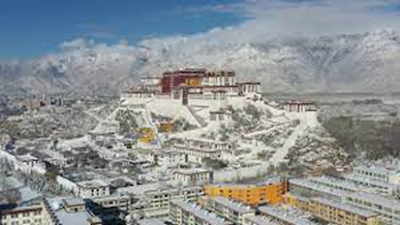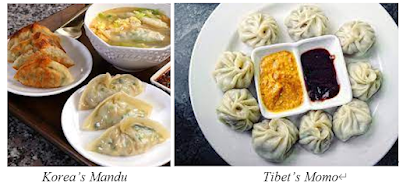Similarities between Korea and Tibet
Similarities between Korea and Tibet
안녕하세요!
[an-nyeong-ha-se-yo: hello in Korean or Hangul]
བཀྲ་ཤིས་བདེ་ལེགས!
[tashi-delek: hello in Tibetan or Bodh Ke]
Tibet and Korea are two countries that belong to the continent of Asia. While Korea is located toward the far-eastern side of Asia, Tibet is located in the central part of Eastern Asia. Presently, the Korean peninsula is divided into 2 parts; Republic of Korea, or commonly known as South Korea and Democratic People’s Republic of Korea, or North Korea, whereas Tibet is currently annexed by the People’s Republic of China. Nevertheless, Tibet is still a country which operates as an individual, independent state under unlawful occupation and is also known as Tibet Autonomous Region of China.
Tibet is situated on the plateau of Tibet, with Lhasa as its capital and is also nicknamed as the “Roof of the World” as its average height is more than 4000 meters above the sea level. South Korea is situated in the Korean peninsula, with Seoul as its capital, nicknamed as the “Land of Morning Calm” due to its scenic and serene countryside.
● Climate
○ Both the countries lie well above the Tropic of Cancer, hence both experience the seasons around the same time and experience snowy winters.
○ Both Korea and Tibet experience summer during the months of June to August, though summer begins earlier in Tibet (March) and ends later (October).
 |
During summers, Korea experiences the blooming
of many summer flowers, like Aster. |
○ Similarly, it is usually a snowy situation in both countries from November-December till March-April.
 |
Tibet in winters are very frequently visited by tourists as it located along the Himalayan mountain ranges. |
● Flag
The South Korean flag, also known as Taegeukgi (태극기) has three parts; a white rectangular background to represent peace and purity, a red and blue Taeguk (태극) in the center, the concept of which relates to the Chinese Taiji, denoting harmony among the positive cosmic forces (red) and the negative cosmic forces (blue) and four black trigrams (괘-Gwae), one in each corner, to represent the movement and harmony of the cosmic forces; Geon (건) representing sky, Gon (곤) representing earth, Ri (리) representing fire and Gam (감) representing water.
The Tibetan flag, also known as Tibetan national flag (བོད་ཀྱི་རྒྱལ་དར།) and as the “Snow Lion flag”, was used by the de facto independent polity of Tibet from 1961 to 1951. It is still being used by the Central Tibetan Administration, according to which, the flag symbolizes:
○ The white triangle in the center represents a snow-clad mountain.
○ Six red stripes among the blue sky to pay tribute to the first Tibetans, six tribes called Se, Mu, Dong, Tong, Dru, and Ra.
○ The yellow sun symbolizes freedom, prosperity and spiritual and material happiness.
○ A pair of snow lions to depict Tibet’s victory of a unified spiritual and secular life.
○ Three supreme gems held by the lions to represent objects of refuge: Buddha, Dharma and Sanga.
○ The lions taking the wheel of Yin & Yang, representing spiritual energy and peoples self discipline of correct ethical behavior.
○ The yellow border symbolizes that Buddha’s teachings are flourishing and spreading.
It was adopted by the 13th Dalai Lama, the spiritual leader of the Tibetan people, stating that he hoped for the country to achieve its true autonomy and that the flag represented the concept of pursuing religious freedom, national equality and mutual respect and not the Tibetan independence movement.
A common aspect between both the flags are that they respect and honor the impact of the positive and the negative cosmic forces, the Yin & Yang symbol and using colors to pass valuable messages.
● People
Majority of the inhabitants of both the lands are natives, originating from the region itself. The next majority of the population in both the regions are the Han-Chinese.
● Cuisine
Korean cuisine is mostly based on rice (as an agricultural product), vegetables and seafood, whereas Tibetan cuisine is mostly based on barley, which is the most cultivated crop in the Tibetan plateau. One of the most popular known Tibetan dish is Thukpa, which is a Tibetan-style noodle soup.
Some similar dishes that I have noticed from the two countries are:
i. Korean Mandu (만두) and Tibetan Momo (མོག་མོག), which are both dumpling-like dishes.
ii. Sujebi (수제비) and Thenthuk (འཐེན་ཐུག་), which are both hand-pulled dough (noodle, in case of Thenthuk) soup.
iii. Rice beer in Korea, it is called Makgeolli (막걸리) and Tibetan rice beer is called Chhaang (ཆང་)
● Flora and Fauna
The only common flora between Korea and Tibet is the Oak tree. More commonly found fauna in the two regions are Tigers, Lynxes, Leopards and Deers. In the Demilitarized Zone between North and South Korea, due to the lack of human inhabitants there, many rare fish species, which are also found in Tibet, are preserved and thrive actively.
● Speech Levels and Regional Dialects
Both Korean and Tibetan language have speech levels, in order to talk respectfully to elders, seniors and younger people.
○ In Korean (한글-Hangul), there are seven speech levels;
Hasoseo-che (하소서체)
Hapsyo-che (하십시오체)
Haoche (하오체)
Hageche(하게체)
Haerache (해라체)
Haeyoche(해요체) and
Haeche(해체). Each level shows a different level of formality and politeness to the listener. Koreans show respect to the person they talk to or about by choosing the appropriate speech level.
○ In Tibetan (བོད་པ་), there are two speech levels;
zhe-sa (honorific) and
phal-skad (ordinary). Their use depends upon the relative social status of the speaker and the listener.
● Religion
When it comes to religion, both the countries follow Buddhism, which also greatly impacted their culture and they also have their own native religions as well.
○ Buddhism:
In Korea, Buddhism first came from China during the 4th century CE, when the country was divided into three kingdoms, Baekje, Goguryeo and Silla. It was only after the unification of the kingdoms when Buddhism started to flourish in Korea, during the 660’s.
In Tibet, Buddhism was first introduced during the reign of King Srong-brstan-sgam-po around the year 627-650. The religion garnered immense encouragement from King Khri-srong-lde-btsan, in whose reign (755–797) the first Buddhist monastery in Tibet was built at Bsam-yas (Samye).
○ Indigenous religion:
In Korea, 'Singyo' is a religion that originates from Korea and is classified as a folk religion.
Similarly, ‘Bon’ is a religion originating from Tibet, which eventually immensely affected Buddhism in Tibet and resulted in the formation of Tibetan Buddhism.
● Native Calendars
Both Korea and Tibet have their own calendars, both of which are lunisolar calendars. The Korean calendar is known as Dangun Calendar. The New Year according to the Dangun Calendar is called ‘Seollal’ (설날). The Tibetan calendar is known as Kalachakra Calendar. The New Year according to the Kalachakra Calendar is called ‘Losar’ (ལོ་གསར་).
● Agroforestry
Korea is mainly known for its modern industries and its fast-paced urban life, but at the same time, agriculture still prevails. Apart from rice, which is cultivated in huge numbers, wheat and barley are also cultivated in Korea, which is also commonly cultivated in Tibet. It is also common for both the countries to obtain some income through the production of wood and woodwork.
Despite the distance, Korea and Tibet share many things in common with each other and I am utterly grateful to be able to learn and share the knowledge with all the viewers!
감사합니다!
ཐུགས་རྗེ་ཆེ་!
धन्यवाद!
Thank you!
________________________________________
References and sources:
■ Wylie, T. V. , Falkenheim, . Victor C. , Richardson, . Hugh E. and Shakabpa, . Tsepon W.D.. "Tibet." Encyclopedia Britannica, October 14, 2023. https://www.britannica.com/place/Tibet.
■ Yu, W. , Hahn, . Bae-ho , Lee, . Chan , Lew, . Young Ick and Im, . Hyug-Baeg. "South Korea." Encyclopedia Britannica, October 26, 2023. https://www.britannica.com/place/South-Korea.
■ National Administration> National Symbols of the Republic of Korea> The National Flag - Taegeukgi.
■ Flag of South Korea - Wikipedia
■ Flag of Tibet - Wikipedia
■ Flag of Tibet
■ https://www.indigenouspeople.net/Tibet/
■ https://www.google.com/url?sa=i&url=https%3A%2F%2Fwww.maangchi.com%2Frecipe%2Fmandu&psig=AOvVaw1zqGN7H9xQvkBfduITi0PE&ust=1698803388663000&source=images&cd=vfe&opi=89978449&ved=2ahUKEwjDyrv1lZ-CAxV22jgGHYFdB9sQr4kDegQIARBz
■ Momo (food) - Wikipedia.
■ Thenthuk - Wikipedia
■ Makgeolli - Wikipedia
■ Chhaang - Wikipedia
■ Kitagawa, J. M. , Snellgrove, . David Llewelyn , Nakamura, . Hajime , Reynolds, . Frank E. , Tucci, . Giuseppe and Lopez, . Donald S.. "Buddhism." Encyclopedia Britannica, October 28, 2023. https://www.britannica.com/topic/Buddhism.










댓글
댓글 쓰기